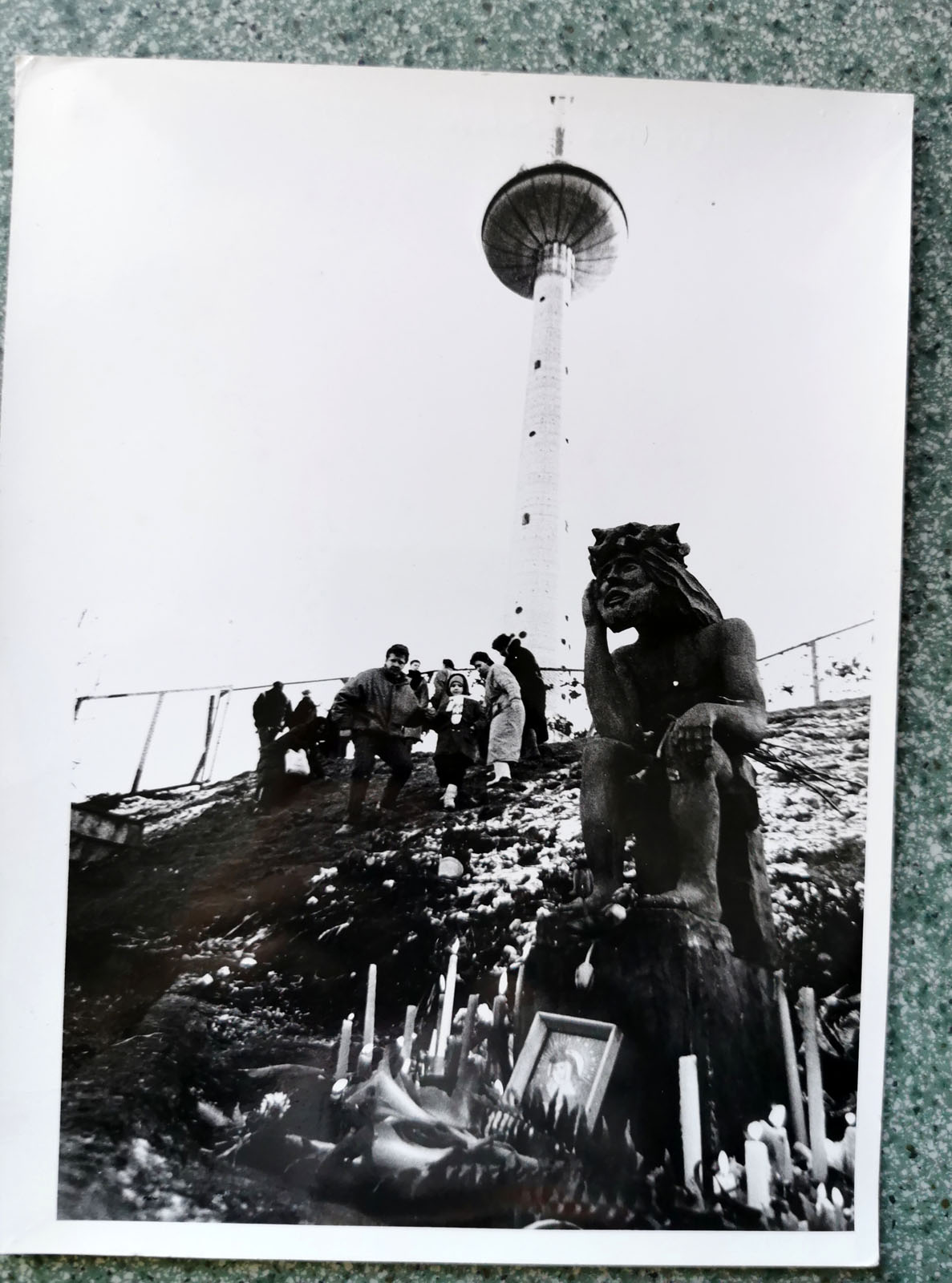January Events 1991 – Fight for Freedom
(Original Lithuanian Text below)

January 13th in the grandmother’s family started as usual, did not stand out from other days of that month. She makes no secret of the fact that some of the impressions have already faded. It’s hard to remember everything because everything happened 30 years ago.
‘It was night. At that time, I was living in Vilnius. I remember feeding my child, and since he was not sleeping yet, I turned on the TV. I heard the song “Freedom” performed by Eurika Masytė. Anxiety trembled in my heart. Later, the images changed like cinema. A crowd of thousands of people appeared on the screen, they were surrounding the Television tower. People were singing Lithuanian songs, and shots suddenly began to be shot. The tanks were riding, it seemed that innocent people were dying one after another. On the run, I ran out into the field and saw a terrible picture.
When the tank rode on the standing ones and pressed them on the tracks, other people tried to push the tank back, but the forces were uneven, the steel machine was standing still. The situation was terrifying. People were running, screaming, they were frightened, everything was drowning in a mist of smoke, but, they, unarmed, were still standing boldly against the tanks. That situation caused a lot of emotion. I was overwhelmed with fear. But in the hearts of the people, courage and hope intertwined with sadness, or even horror: how can this be possible.
The soldiers fired over people’s heads with rebound bullets at the glass windows of the building. Bullets hitting a hard surface changed direction from inertia and hit human bodies. Hail of glass poured on people’s heads. Many people were seriously or fatally injured. The people did not run away and defended the independence of the nation with all their hearts. Some fell from bullets, others under the wheels of Russian tanks. A poster appeared above the people’s heads: “It’s better to die standing than to live while kneeling.”
It was appalling to see the atrocities committed by armed soldiers. With the rifles they were beating everyone in a row, whether it was a man or a woman, fired wherever they wanted and were pushing their way towards the TV tower. 11 defenders were killed on the spot, 3 more died at the hospital and 702 people were injured, most of them men. Thanks to the filming cameras, these events were recorded and the whole world learned the truth.
Journalists who were working in the Television tower that night had barricaded themselves and locked the door. They kept reporting on events taking place in and around the building. I came home to check if the baby was asleep and turned on the TV as soon as possible.’
E. Bučelytė’s voice was heard through the control speakers that the television studio was being attacked. Explosions and shootings were heard. The light disappeared. While the console still appeared to be working, the microphones were on, the operators reported that the voices of the speakers were no longer heard.
At that time, some journalists who were in the LRT building, were keeping in touch with foreign countries or rewriting tapes, which were later transported to the West to show what was happening in Lithuania, while others were working from the Seimas or on duty at the TV tower.
The fight continued for several more months. Road workers from Vilnius and Vievis took part in the fight for Independence. They built barricades near the Seimas. The wall that emerged from the barricades and human hedges was insurmountable to the occupiers. Such barricades were also built in other cities near important state buildings. People took buses and cars to the heart of Lithuania, Vilnius, and joined local fighters for freedom.
The mass peaceful resistance of Lithuanian citizens that took place that night was targeted against the attempts of Soviet leadership to seize the Vilnius TV Tower, the Radio and Television Committee building, the Parliament building and other significant objects and to take control of them. The people proved their unity and courage. They stood in front of a group of paratroopers armed with heavy military equipment. Young people were particularly active. At night, the students, unnoticed by their parents, jumped over the balconies and went to fight for the Homeland.
On January 15, a large crowd gathered in Vilnius, in the Cathedral Square and near the Sports Palace to honour and accompany those who died for the freedom of Lithuania on their last trip.
Following the failure of the coup, the occupiers withdrew from Lithuania on 23 August. That’s how Grandma finished her story.
(Pakruojis Atžalyno Gymnasium)

Sausio 13-oji močiutės šeimoje prasidėjo įprastai, neišsiskyrė niekuo nuo kitų šio mėnesio dienų. Ji neslepia, kad kai kurie įspūdžiai jau spėjo išblėsti. Sunku viską prisiminti, nes viskas vyko prieš 30 metų.
-Buvo naktis. Tuo metu gyvenau Vilniuje Pamaitinau vaikelį, o kadangi jis dar nemiegojo, įsijungiau televizorių. Išgirdau Eurikos Masytės atliekamą dainą ,,Laisvė“. Širdyje suvirpėjo nerimas. Vėliau vaizdai keitėsi kaip kine. Ekrane pasirodė daugiatūkstantinė žmonių minia, juosianti televizijos bokštą. Žmonės traukė lietuviškas dainas, staiga aplinkui ėmė aidėti šūviai. Važinėjo tankai, atrodė, kad nekalti žmonės miršta vienas po kito. Bėgte išbėgau į lauką ir pamačiau kraupų vaizdą.
Kai tankistas užvažiavo ant stovėjusiųjų ir prispaudė juos vikšrais, kiti žmonės bandė stumti tanką atgal, bet jėgos buvo nelygios, plieninė mašina nė nekrustelėjo. Situacija buvo kraupi. Žmonės lakstė, klykė, buvo išsigandę, viskas skendėjo dūmų migloje, tačiau, nors ir beginkliai, vis tiek drąsiai stojo prieš tankus. Tokia padėtis kėlė daug emocijų. Mane apniko baimė. Tačiau žmonių širdyse drąsa ir viltis pynėsi su liūdesiu, ar net siaubu: kaip šitaip galima.
Kareiviai šaudė virš žmonių galvų rikošetinėmis kulkomis į pastato stiklinius langus. Kulkos, atsitrenkusios į kietą paviršių, iš inercijos keitė kryptį ir smigo į žmonių kūnus. Ant žmonių galvų pasipylė stiklų kruša. Daug žmonių buvo sunkiai arba mirtinai sužeista. Žmonės nepabūgo ir visa širdimi savo kūnais gynė tautos nepriklausomybę. Kai kurie krito nuo kulkų, kiti – po rusų tankų vikšrais. Virš galvų pasirodė plakatas: ,,Geriau mirti stovint, negu gyventi klūpant“.
Pasibaisėtina buvo matyti ginkluotų kareivių daromus žiaurumus. Šautuvų buožėmis jie mušė visus iš eilės, nesvarbu, ar tai vyras, ar moteris, šaudė kur papuolė ir taip brovėsi prie televizijos bokšto. Vietoje žuvo 11 gynėjų, ligoninėje mirė dar 3, sužeisti – 702 žmonės, dauguma jų- vyrai. Filmavimo kamerų dėka buvo užfiksuoti šie įvykiai ir visas pasaulis sužinojo tiesą.
Tą naktį televizijos bokšte dirbę žurnalistai buvo užsibarikadavę ir užsirakinę duris. Jie nuolat pranešinėjo apie įvykius, vykstančius pastate ir aplink jį. Grįžau namo patikrinti ar neužmigo vaikelis ir kuo skubiausiai įsijungiau televizorių.
Per kontrolinius garsiakalbius pasigirsta E. Bučelytės balsas, kad atakuojama televizijos studija. Girdisi sprogimai, šaudymai. Dingsta šviesa. Nors pultas atrodo dar dirba, mikrofonai įjungti, operatoriai praneša, kad kalbančiųjų balsų jau nebesigirdi.
Vieni žurnalistai tuo metu buvo LRT pastate, palaikė ryšį su užsieniu ar perrašinėjo kasetes, kurias vėliau vežė į Vakarus parodyti, kas vyko Lietuvoje, kiti dirbo iš Seimo ar budėjo prie TV bokšto.
Kova tęsėsi dar keletą mėnesių. Į kovą už Nepriklausomybę įsitraukė kelininkai iš Vilniaus ir Vievio. Jie statė barikadas prie Seimo rūmų. Iš barikadų ir žmonių gyvatvorės išdygusi siena okupantams buvo neįveikiama. Tokios barikados buvo statomos ir kituose miestuose prie svarbių valstybinių pastatų. Žmonės autobusais, mašinomis vyko į Lietuvos širdį Vilnių ir prisijungdavo prie vietinių kovotojų už laisvę.
Tą naktį įvykęs masinis taikus Lietuvos piliečių pasipriešinimas Sovietų Sąjungos vadovybės bandymui jėga paimti į savo rankas Vilniaus televizijos bokštą, Radijo ir televizijos komiteto pastatą, Parlamento pastatą ir kitus reikšmingus objektus, perimti jų kontrolę, įrodė žmonių vienybę ir drąsą. Jie mūru stojo prieš sunkiąja karine technika ginkluotą desantininkų grupę. Ypač aktyvus buvo jaunimas. Moksleiviai naktimis, nepastebėti tėvų, iššokdavo per balkonus ir eidavo kovoti už Tėvynę.
Sausio 15-ąją didelė žmonių minia Vilniuje, Katedros aikštėje ir prie Sporto rūmų susirinko pagerbti ir palydėti į paskutinę kelionę žuvusiųjų už Lietuvos laisvę.
Nepavykus perversmui, rugpjūčio 23 dieną okupantai pasitraukė iš Lietuvos. Taip savo pasakojimą baigė močiutė.
(Pakruojo “Ąžuolyno” Gymnasium)
